tyro
Harmless

Posts: 31
Registered: 22-12-2021
Member Is Offline
|
|
Interesting route to 4-methoxyphenol
The following publication details an approach to the monoetherification of 1,4-hydroquinone and various derivatives thereof, using NaNO2 as
the free-radical initiator.
Selective Monoetherification of 1,4-Hydroquinone Promoted by NaNO2
DOI:10.2174/1385272811317100011
I had originally planned to approach 4-methoxyphenol using benzoquinone as the free-radical initiator; however, I had none on hand and didn't want to
bother with making the stinky stuff...
It doesn't appear that this approach using sodium nitrite has been documented here (used site search and google), so I thought I'd share my account of
it.
The Expirement:
55g Hydroquinone
1.72g NaNO2
28.75ml 96% H2SO4
500ml MeOH
To a 1L RBF filled with methanol was added hydroquinone and sodium nitrite with good mixing. Once everything had dissolved, sulfuric acid was added at
a rate as to keep the reaction mixture relatively cool (temperature reached 45°C at peak). During addition of the sulfuric acid, the mixture
transitioned from a light pink to a dark red-brown hue; there was evolution of some nitrogen dioxide. After addition of the sulfuric acid, the
reactants were stirred for 22H at RT.
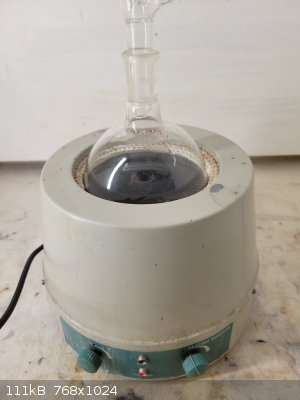
At this point, the reaction mixture was poured into a bowl and let to evaporate down to about 250ml under air flow of the fume hood.
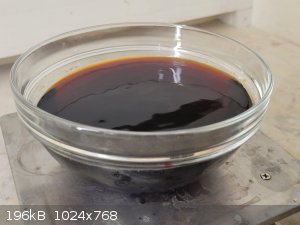 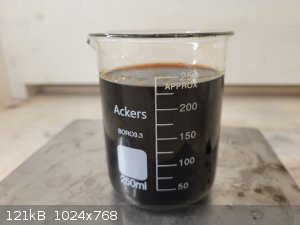
This mixture was then transferred to a 500ml separatory funnel, 150ml of water was added, and then extracted with 5 x 50ml portions of toluene. Some
methanol appeared to carry over.
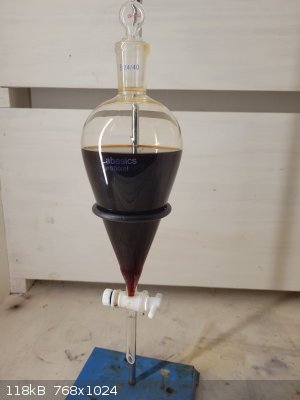 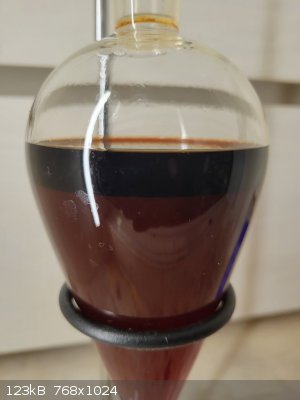
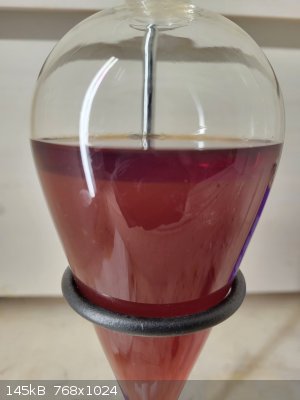 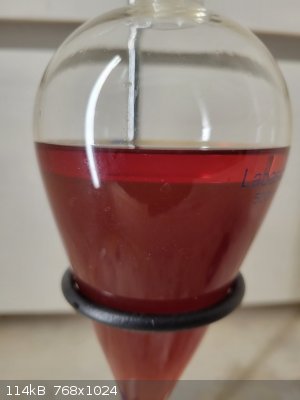
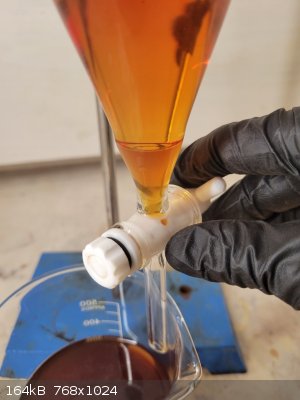 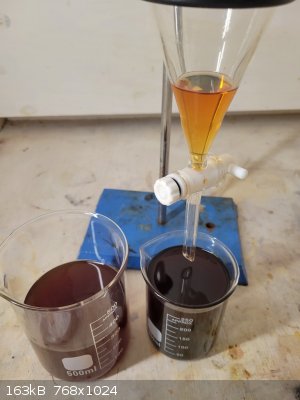
The pooled toluene extracts were then transferred to a 500ml flask, then subsequently 250ml flask, and the solvent volume was reduced under vacuum.
(I'd normally use a water cooled condenser in a situation like this; not sure why I didn't. Rushing things? A fair bit of methanol and toluene
ended up in the vacuum pump's trap... oh well).
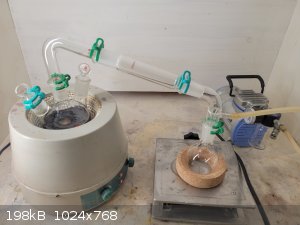 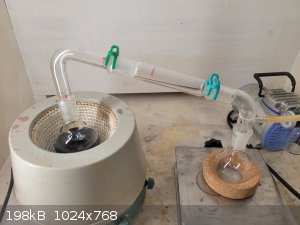
Once the volume of solvent had been considerably reduced, the remaining extract was placed in a 100ml flask, remaining solvent stripped, and then the
4-methoxyphenol was vacuum distilled over. A heat gun was used at times to aid the migration of the phenol along the condenser.
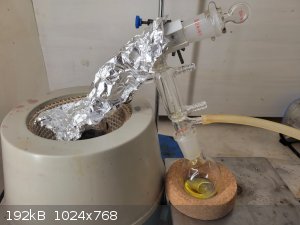 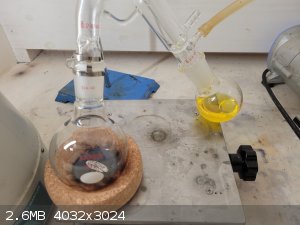
Crude product.
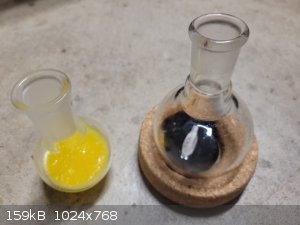
The crude product was recrystallized from heptane and toluene (roughly 1:3). Multiple stints in the freezer with some evaporation of the solvent
mixture was required to get the remaining phenol out after the first crop of crystals.
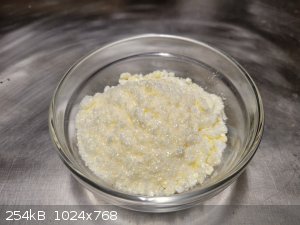
Final yield was 32g of 4-methoxyphenol (51.6%). MP was measured to be 48°C-52°C (Lit 52.5°C).
I'm sure there were some losses in the workup. Also the reaction wasn't run for the full 24H, so perhaps that played into the yield being lower than
in the paper.
Some Notes:
I ran this experiment at a couple other scales. One before this starting with 10g of hydroquinone, and one after using 44g. The 10g run was performed
at RT, while the last one was done for 4h at reflux. In both cases, the reaction mixture never darkened quite like the run above, and the workup
yielded less product.
I can't say for sure, but it seems like there might be a factor of concentration which comes in to play here. In these other cases not detailed, the
concentration of the hydroquinone to methanol was < 1g/10ml, while the case above was > 1g/10ml. It's possible I goofed in some other way.
Further investigation would be needed, though I doubt I'll re-visit the matter soon.
The smell of this is really interesting. I've previously made 1,4-dimethoxybenzene from hydroquinone and dimethyl carbonate. The dimethoxybenzene was
intensely floral and sweet, almost candy-like, at the same time. Very unique. 4-methoxyphenol seems to sit in an interesting place: relatively close
to the smell of dimethoxybenzene, but not as intense, with slight notes of phenol. Somewhat floral and medicinal at the same time.
|
|
|
Fery
International Hazard
    
Posts: 1010
Registered: 27-8-2019
Location: Czechoslovakia
Member Is Offline
|
|
Well done, thanks for sharing!!! You performed a lot of steps, this synthesis is at some advanced level!
Interesting findings, there is big excess of methanol and the NaNO2 catalyzes only monoetherification, as there is also H2SO4 the catalyst is some
nitrogen oxide - in the link they wrote about NO2 which oxidizes one -OH group of hydroquinone into =O (semiquinone) and this is the reactive
intermediate which undergoes monoetherification.
Also thanks for describing the scent of the product! I like nice smelling compounds.
Your product after vacuum distillation has also interesting yellow color - perhaps it was caused by the presence of at least a little of quinones and
then you purified your product by crystallization as the last step.
|
|
|
xdragon
Harmless

Posts: 9
Registered: 4-8-2020
Member Is Offline
|
|
Nice work, shame that the yield was on a rather low side. I'd be interested in seeing your synthesis of 1,4-dimethoxybenzene from hydroquinone and
dimethyl carbonate too 
|
|
|
Pumukli
National Hazard
   
Posts: 697
Registered: 2-3-2014
Location: EU
Member Is Offline
Mood: No Mood
|
|
In these days I'm working on exactly the same synthesis.  Especially for the
scent! (Not the scent of the 4MeOPhe, but I'd like to prepare another "smelly" compound for which the synthesized 4MeOPhe is one of the starting
materials.) Especially for the
scent! (Not the scent of the 4MeOPhe, but I'd like to prepare another "smelly" compound for which the synthesized 4MeOPhe is one of the starting
materials.)
I use the NaNO2 method tyro posted (thanks, tyro, you saved me time to make crappy photos, yours are much better!) 
I tried to "optimize" this route. Although I'm only at the 3rd iteration on a 1/10th scale as of tyro's, I found that the best isolated yield was 65%
so far. I could achieve it when I neutralized the RM in Na2CO3/water and extracted the 4MeoPhe with chloroform, distilled the chloroform off at normal
pressure and vacuum distilled the rest.
I also found that the dark reddish-black RM can be decolorized to straw color in 15 minutes by boiling it with a small amount of zinck powder. (I used
this method to destroy the excess/remaining benzoquinone in the end and it gave this side effect.)
The vacuum distilled liquid was water clear (not yellowish) and gave snow white crystalls on cooling. The melting point was 54.3-55.4 C.)
Btw, 2 and a half hours reaction time was enough at around 25 Celsius. For 65% it is for sure. (Though there was a "lot" crystalls in the
cooler/flasks and we all know that the last drops of such high boiling compound is hard to distill off under not too strong vacuum. I used a water
aspirator, which could boil water around 19 Celsius. 4MeOPhe came over at 120 C but I had to increase the temperature of the hot plate to 300 C ! The
contact was not the best, obviously, and it probably caused a lot of scorching in the end, despite the zinc powder.)
Btw2: on the photo of my "TLC challenge" of last week the first spot was hydroquinone, the others from the sampled reaction mixture of this synth.

Here's the result of the vacuum distillation: /The date on the pic is misleading. My phone restarted before the picture was taken and being a "dumb
phone" it could not synchronize itself to a central clock./
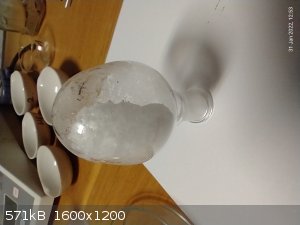
[Edited on 11-11-2022 by Pumukli]
[Edited on 11-11-2022 by Pumukli]
|
|
|
Boffis
International Hazard
    
Posts: 1859
Registered: 1-5-2011
Member Is Offline
Mood: No Mood
|
|
@ tyro; nice work and an excellent write-up. There are echoes of this method in benignium's write-ups on the preparation of various substituted
aldehydes in his Phenylethylamine thread. Keep up the good work.
|
|
|
tyro
Harmless

Posts: 31
Registered: 22-12-2021
Member Is Offline
|
|
Fery - Glad you chimed in! I've come across a number of your posts prior to becoming active on the board. The ones where you're
making nice smelling things are always fun to read about. I have zingerone in my queue to get to. Came across a paper detailing it's synthesis from
vanillin and acetone, where the hydrogenation is accomplished with NaBH4 and (what seems like an excessive amount of) catalytic
NiCl2. Hoping to get to it early next year.
xdragon - I've been meaning to make a thread on o-methylations using dimethyl carbonate. It's a pretty straightforward reaction,
though not necessarily friendly from an equipment standpoint. Yields can vary, though I haven't necessarily run optimizations on each target.. It
requires a vessel which can withstand a fair bit of pressure. I use a hydrothermal reactor rated for about 6MPa. I've run this reaction on a handful
of substituted benzenes. It's been interesting trying to find the best workup afterwards for each target. Definitely a learning experience!
Pumukli - Thanks for sharing your experiences with this route! Good thinking on destroying the benzoquinones with zinc dust - I'll
keep this in mind for future runs. And only 2.5 hours at 25C for reaction? Super interesting.. I'm curious if you've noticed anything with regard to
concentration of hydroquinone in methanol affecting the reaction? Also, I had a similar experience with distilling - the hotplate was cranked all the
way up, but the last bits of 4-methoxyphenol were stubborn in coming over. Even at 200mbar.
Boffis - Thanks! That thread was one of many motivators for becoming an active contributor. I've also had an ever growing feeling of
wanting to give back to a community that I've learned so much from for nearly 10 years.
|
|
|
tyro
Harmless

Posts: 31
Registered: 22-12-2021
Member Is Offline
|
|
Another potentially interesting route..
I'm currently working out another potentially interesting route to 4-methoxyphenol, starting from p-hydroxyacetanilide (acetaminophen/paracetamol).
I had previously thumbed through the benzoquinone from paracetamol in regard to making hydroquinone. This last experiment consumed the last of my hydroquinone, and, rather than buying
more, I was thinking about making my own for the learning process (there are some interesting reactions I have yet to perform). Though it's not
necessarily economically practical, I've become ensnared with the idea of arriving at 4-methoxyphenol from 4-hydroxyacetanilide.
The first thing that came to mind was hydrolysis of p-hydroxyacetanilide to p-hydroxyaniline, then diazotization and degredation of the aniline to
hydroquinone, followed by the usual methods.
On the surface, this seemed like a lot of steps (4 total) and many potential areas for loss before even getting to making 4-methoxyphenol, especially
if isolating in each step. This merely re-enforced the lack of economical benefit to this approach. But, again, I'm in it for the experience and to
learn.
Then, I came across an interesting paper:
Functionalized alkoxy arene diazonium salts from paracetamol
https://doi.org/10.1039/b924619c
Here, they produce an O-alkylated, de-acetylated, diazonium derivative of 4-hydroxyacetanilide in a series of reactions taking place in a single
reaction vessel. The prospect of running the reaction in a single vessel (and in only 3 steps) seemed appealing, but the steps and reagents they were
using didn't seem to provide much advantage in the way of ease. In this case, the methoxy group would be set before diazotization, using methyl
iodide, which seems less advantageous than getting there from the sort of free-radical reaction performed above.
Okay. So now what? I recalled that 4-hydroxyacetanalide undergoes undergoes metabolic transformations to a quinone derivative, which was discussed in the benzoquinone thread linked above. This, along with my understanding that diazonium salts degrade to
different products under different conditions (see here), got me wondering if there might be some potential overlap in degradation mechanisms of the diazonium salts, acetaminophen's propensity to
form quinone derivatives, and the reaction previously formed which relied on a benzoquinone intermediate.
After some searching, It seems there in fact is.
I found a thesis paper, which details some previous work on degradation of benzenediazonium chlorides in alcohols in the course of an investigation of the
same on benzenediazonium sulfates. Here, the degradation of the benzenediazonium chloride in alcohol, leads to the corresponding alkoxyphenol in what
is described as a free-radical reaction. Degradation of the sulfate form was a bit more troublesome, in that the benzene was produced more readily
under similar conditions. Though this seems to be mitigated, by increasing the starting concentration of sulfuric acid (decomposition of the
benzenediazonium salt frees more of the corresponding acid as the reaction proceeds).
So, at this point, I'm thinking:
One-pot reaction: acidic hydrolysis -> diazotization -> decomposition -> target, all under alcoholic conditions.
Seems much better than before! Only 3 steps, and no really special reagents.
But, it looks like there may be yet more room to improve..
While I was on this train of thought, I come across another reference:
The Mechanism of the Reaction of N-Nitrosoacetanilide with Methanol
https://doi.org/10.1021/ja01148a013
This seems to indicate that the previous mechanisms hold as well for degradation of aryl N-nitrosamines. They do however, seem to contest that the
mechanism is free-radical in nature. In any case, the reaction appears to have similar parameters. Namely, that the benzene may be produced along with
the alkoxyphenol in the case of the sulfate salt, and the ratio of products is dependent on the starting concentration of sulfuric acid and other
factors like concentration of acetate and acetic acid (acetic acid is produced as a byproduct of the reaction in this case, and would be present in a
one-pot reaction incorporating hydrolysis).
Where I'm at now is:
N-nitrosylation of 4-hydroxyacetanilide -> degradation -> 4-methoxyphenol, all in methanol.
This would be only 2 steps from acetaminophen to 4-methoxyphenol (likely contaminated with plain phenol).
Though using the diazonium or N-nitrosamide sulfate salts appears to lead to the corresponding benzene, rather than the alkoxyphenol, I'm thinking
this is the best approach with respect to ease. Much easier to add conc sulfuric acid to methanol, than bubbling in dry HCL.
I've got a bit to hammer out before getting to trials here. But it seems promising on the surface.
Apologies if there are any glaring errors here, it's quite late here.
[Edited on 13-12-2022 by tyro]
|
|
|
tyro
Harmless

Posts: 31
Registered: 22-12-2021
Member Is Offline
|
|
Apologies, I had a typo and it seems I can no longer edit it. N-nitrosylation should be N-nitrosation.
|
|
|
clearly_not_atara
International Hazard
    
Posts: 2779
Registered: 3-11-2013
Member Is Offline
Mood: Big
|
|
I would be interested to find out what the nitrosation product of paracetamol is. If you get N-nitration, that's great. But if the phenol is
deprotonated, then I would be inclined to expect ring nitrosation. So neutral to acidic conditions are recommended.
|
|
|
tyro
Harmless

Posts: 31
Registered: 22-12-2021
Member Is Offline
|
|
Thanks for your reply, clearly_not_atara!
I actually was reading the Possible route to resorcinol from Tylenol / Paracetamol thread the other day, where there was some discussion about the potential nitrosation of
paracetamol. Along with a mention of the ambiguity of formed products
Deprotonation would occur in the presence of a base strong enough to act on phenol, right? Under my current thinking, the phenol would not be made
into the phenoxide prior to reaction as it should be plenty soluble in methanol. NaNO2 and formed Na2SO4 pose no risk
to deprotonation.
So what I'm thinking:
Methanol
1 eq paracetamol
2 eq H2SO4 (plus some additional amount to increase initial concentration for the decomposition, so that 4-methoxyphenol is
favored over phenol)
1 eq NaNO2
Add acid, paracetamol to methanol, chill to 0C, slowly add solution of sodium nitrite in methanol (or perhaps water) while maintaining 0C. Once
nitrosation is complete, warm reaction vessel to 40C and let decomposition occur.
Concerns/questions I'm currently doing some researching to resolve:
- Optimal volume of methanol for reaction to proceed and avoid potential sulfonation. Perhaps it makes sense to add the additional sulfuric acid for
decomposition after nitrosation.
- Given lower solubility of sodium nitrite in methanol, would it make sense to add it as a concentrated aqueous solution? If attempting as a one-pot
reaction, anhydrous conditions should be used during decomposition to avoid formation of, presumably, hydroquinone. Perhaps the formed sodium sulfate
would be sufficient to pull the water out of the reaction.
- Should I expect the decomposition to eliminate all of the N-nitroso compound? Or perhaps some way to destroy any remaning after decomposition. I'm
trying to avoid handling terribly carcinogenic materials.
- What are all the potential side products at each step, how might they affect the reaction, workup, and so on. Much is covered in the papers above,
but I'd like to think through the specific ones formed in this reaction.
With regard to the ambiguity of the nitrosation product: I could potentially attempt an isolation prior to decomposition to try to analyze the
product, but I'd really prefer not to deal with carcinogenic substances. Also, I'm unsure of the stability of this compound, as it seems many
diazonium compounds seem prone to dangerous decomposition when concentrated. Not sure if the same holds for nitrosamines. It may be sufficient to
elucidate the product formed from nitrosation from the decomposition products.
|
|
|
tyro
Harmless

Posts: 31
Registered: 22-12-2021
Member Is Offline
|
|
Attempt with acetaminophen
Last weekend I got around to running a trial on the nitrosation and decomposition of acetaminophen in methanol with sulfuric acid.
I was unable to successfully extract any of the reaction product, but there were some interesting/encouraging aspects to the test.
--
Experimental:
5g (33.08 mmol) Acetaminophen
7g (66.5 mmol) 93.2% H2SO4
2.28g (33.08 mmol) NaNO2
Acetaminophen was added to a 50ml boiling flask and dissolved in 30ml of methanol. Then, sulfuric acid was added and the flask was put in an ice bath
and cooled to ~2°C. Sodium nitrite dissolved in 3.2ml H2O was added using a dropper at such a rate that the temperature never exceeded
4°C (~15m). ~5-10ml methanol were used to rinse the beaker which had the sodium nitrite/water solution. A precipitate of sodium sulfate immediately
formed at the beginning of addition and thickened considerably by the end. The mixture was then allowed to stir for 1h. Color through this time went
from light pink, to light tan, then darker brown, and finally almost green towards the end.
After 1h, the reaction mixture was allowed to warm to room temperature. As it reached around 20°C, a very small amount of bubbling was observed. The
mixture was left to stir for 17h at RT. The bubbling seemed to drop off pretty significantly after a few hours, though it was pretty minimal to begin
with. Color shifted to a dark crimson at the end.
The following day, the mixture was brought to reflux for 45m in an attempt to destroy any remaning nitrosamine. It was then allowed to cool and 1.32g
(22.08 mmol) NaOH in ~10ml methanol was added. The solution remained acidic, possibly due to liberated acetic acid. Reflux was continued for 15m more,
then the whole lot allowed to cool to RT. Once cool, the reaction mixture was vacuum filtered. The filtered precipitate had a very strong smell
somewhere between phenol and p-dimethoxybenzene.
The filtrate was then reduced to 1/3 volume, added to a separatory funnel, diluted with 100ml H2O, and extracted with 3 portions of 15ml
DCM. A black tarry layer formed above the DCM and remained in the aqueous phase. Solvent was then removed by boiling from the pooled extracts, but
only a minuscule amount of a dark red oily substance remained. An attempt was made to further purify it by boiling it in n-heptane and decanting;
nothing but more tar and interesting shades of red happened. The tar from the aqueous layer was also filtered off and some extraction attempts were
made on it, but nothing of note came of this.
Ultimately I abandoned the workup, as it got a bit messy and I wasn't seeing a clear path forward. The encouraging part of all of this was the smell.
During the entirety of the attempted workup, the smell of phenol and p-methoxyphenol was abundantly clear. These would be two of the expected products
of this reaction, as lined out in one of the papers I linked above.
I'm wondering if the use of water to dissolve the sodium nitrite might have negatively impacted things here. The total amount should have been just
over the molar quantity needed to form the pentahydrate of sodium sulfate. However, I'm not certain that the salt is necessarily effective at pulling
water from the solution.
Additionally, I'm not certain if neutralizing the sulfuric acid during workup was necessary or if too much water was added during dilution. It was
also strange that addition of the DCM resulted in tar formation during extraction.
I didn't bother with a vacuum distillation, as I had issues purifying small amounts of this compound that way previously (or rather, it was a pain).
Since I had luck with purifying with n-heptane in the route from hydroquinone, it seemed reasonable to try that for this approach. Perhaps it would be
worth a shot to neutralize the reaction mixture totally, accounting as well for the liberated acetic acid, distill off the methanol, and vacuum
distill what's left.
I'm going to chalk the lack of an isolated product to the fact that this was a trial run, I was making some guesses, and this was my first time
running a nitrosation. With some tuning, I think there might be a viable path forward here. At least, it seems worth further investigation.
|
|
|
Benignium
Hazard to Others
  
Posts: 115
Registered: 12-6-2020
Member Is Offline
Mood: Quasi-catatonic
|
|
Fantastic thread, tyro!
The paracetamol angle is fascinating, and I admire your ambition in working toward a one-pot procedure. I don't have much to contribute to this, but I
know that the diazotization is similarly exploited in clandestine preparations of GBL/GHB from GABA, and I'm hopeful that the strategy can be feasible
here as well. However, it seems to me like you had best protect the phenol via O-methylation first; the Liebermann reagent, a mixture of
KNO2 and sulfuric acid, is used to identify phenolic compounds by exploiting their tendency to form colored indophenol compounds (this
could explain the poorly soluble tar you observed on dilution).
[Edited on 2-2-2023 by Benignium]
|
|
|
AvBaeyer
National Hazard
   
Posts: 649
Registered: 25-2-2014
Location: CA
Member Is Offline
Mood: No Mood
|
|
The reaction of acetaminophen with nitrous acid is qualitatively different from the reaction of nitrous acid with acetanilide. The phenolic group of
acetaminophen activates the benzene ring such that you end up nitrosating/nitrating the ring competitively with the nitrosation of the amide nitrogen.
This is why your reaction is a mess. Even if you protect the phenolic group there will likely still be ring reactivity competitive with amide
nitrosation. If you want the monomethyl ether of hydroquinone you will need to methylate the phenol, hydrolyze the amide, and then convert the amino
group to a phenol. Hydrolysis of acetaminophen to p-hydroxyaniline and then trying to convert the amino group directly to a methoxy group will be a
frustrating learning experience.
AvB
|
|
|
tyro
Harmless

Posts: 31
Registered: 22-12-2021
Member Is Offline
|
|
@Benignium - I actually found inspiration/motivation to pursue the paracetamol angle from a side note in your phenethylamine thread. While
hydroquinone is cheap and readily available, I'm fascinated by the idea of using common OTC materials. Very interesting point on the Liebermann
reagent.
@AvBaeyer - Thanks for your input and notes on the difficulties/improbabilities on different aspects of this approach. I figured that there would be
some substantial differences in reactivity here, but curiosity got the best of me before I was able to better inform myself. A bit of frustration is
not an issue, but a dose of knowledge and information goes a long way. Much appreciated!
Back to the drawing board.
|
|
|
|